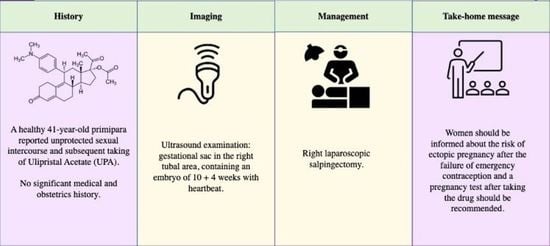A Case of Advanced Tubal Ectopic Pregnancy after Emergency Contraception
Abstract
:1. Introduction
2. Clinical Case
3. Discussion
4. Conclusions
Author Contributions
Funding
Institutional Review Board Statement
Informed Consent Statement
Data Availability Statement
Conflicts of Interest
PRECIS
References
- Committee on Practice Bulletins—Gynecology. ACOG Practice Bulletin No. 191: Tubal Ectopic Pregnancy. Obstet. Gynecol. 2018, 131, e65–e77. [Google Scholar] [CrossRef] [PubMed]
- Centers for Disease Control and Prevention. Ectopic pregnancy—United States, 1990–1995. Morb. Mortal. Wkly. Rep. 1995, 44, 46–48. [Google Scholar]
- Brown, D.L.; Doubilet, P.M. Transvaginal sonography for diagnosing ectopic pregnancy: Positivity criteria and performance characteristics. J. Ultrasound Med. 1994, 13, 259–266. [Google Scholar] [CrossRef] [PubMed] [Green Version]
- Stika, C.S. Methotrexate: The Pharmacology Behind Medical Treatment for Ectopic Pregnancy. Clin. Obstet. Gynecol. 2012, 55, 433–439. [Google Scholar] [CrossRef] [PubMed]
- Raymond Li, H.W.; Resche-Rigon, M.; Bagchi, I.C.; Gemzell-Danielsson, K.; Glasier, A. Does ulipristal acetate emergency contraception (ella®) interfere with implantation? Contraception 2019, 100, 386–390. [Google Scholar]
- Gauvin, C.; Amberger, M.; Louie, K.; Argeros, O. Previously asymptomatic ruptured tubal ectopic pregnancy at over 10 weeks’ gestation: Two case reports. Case Rep. Women’s Health 2018, 21, e00089. [Google Scholar] [CrossRef] [PubMed]
- Goswami, D.; Agrawal, N.; Arora, V. Twin tubal pregnancy: A large unruptured ectopic pregnancy. J. Obstet. Gyaecol. Res. 2015, 41, 1820–1822. [Google Scholar] [CrossRef] [PubMed]
- Funamizu, A.; Fukui, A.; Fukuhara, R.; Kobayashi, A.; Chiba, H.; Matsumara, Y.; Miunuma, H. A case of bilateral tubal pregnancy. Gynecol. Minim. Invasive Ther. 2017, 6, 191–192. [Google Scholar] [CrossRef] [PubMed]
- Raymond Li, H.W.; Sue Seen Tsing, L.; Pak-Chung, H. Emergency contraception. Best Pract. Res. Clin. Obstet. Gynaecol. 2014, 28, 835–844. [Google Scholar] [CrossRef] [PubMed]
- Kozinszky, Z.; Bakke, R.T.; Lieng, M. Ectopic pregnancy after levonorgestrel emergency contraception. Contraception 2011, 83, 281–283. [Google Scholar] [CrossRef] [PubMed]
- Kaymak, O.; Simsek, Y.; Doganay, M.; Yildiz, Y.; Mollamahmutoglu, L. Ectopic pregnancy following levonorgestrel emergency contraception: A case report. J. Turk. Ger. Gynecol. Assoc. 2010, 11, 168–169. [Google Scholar] [CrossRef] [PubMed]
- Cleland, K.; Raymond, E.; Trussell, J.; Cheng, L.; Zhu, H. Ectopic pregnancy and emergency contraceptive pills: A systematic review. Obstet. Gynecol. 2010, 115, 1263–1266. [Google Scholar] [CrossRef] [PubMed] [Green Version]


Publisher’s Note: MDPI stays neutral with regard to jurisdictional claims in published maps and institutional affiliations. |
© 2022 by the authors. Licensee MDPI, Basel, Switzerland. This article is an open access article distributed under the terms and conditions of the Creative Commons Attribution (CC BY) license (https://creativecommons.org/licenses/by/4.0/).
Share and Cite
Restaino, S.; Degano, M.; Padovani, D.; Biasioli, A.; Capodicasa, V.; Vizzielli, G.; Driul, L. A Case of Advanced Tubal Ectopic Pregnancy after Emergency Contraception. Healthcare 2022, 10, 1590. https://doi.org/10.3390/healthcare10081590
Restaino S, Degano M, Padovani D, Biasioli A, Capodicasa V, Vizzielli G, Driul L. A Case of Advanced Tubal Ectopic Pregnancy after Emergency Contraception. Healthcare. 2022; 10(8):1590. https://doi.org/10.3390/healthcare10081590
Chicago/Turabian StyleRestaino, Stefano, Matilde Degano, Diana Padovani, Anna Biasioli, Valentina Capodicasa, Giuseppe Vizzielli, and Lorenza Driul. 2022. "A Case of Advanced Tubal Ectopic Pregnancy after Emergency Contraception" Healthcare 10, no. 8: 1590. https://doi.org/10.3390/healthcare10081590
APA StyleRestaino, S., Degano, M., Padovani, D., Biasioli, A., Capodicasa, V., Vizzielli, G., & Driul, L. (2022). A Case of Advanced Tubal Ectopic Pregnancy after Emergency Contraception. Healthcare, 10(8), 1590. https://doi.org/10.3390/healthcare10081590







